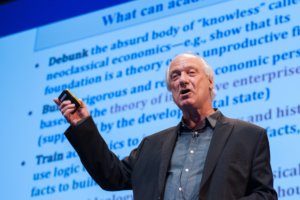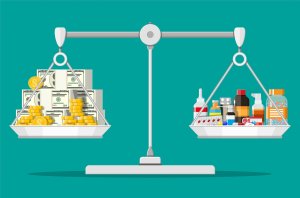We want an economy that generates stable and equitable growth—or what I call “sustainable prosperity.” We want productivity growth that makes it possible for the population to have higher living standards over time. We want an equitable sharing of the gains from productivity growth among those whose work efforts and financial resources contribute to that growth. And we want sufficient job stability to enable workers to remain in productive employment for some four decades at work while providing them with enough savings to provide them with adequate incomes over some two decades of retirement.
We need innovative enterprise to achieve sustainable prosperity. Innovation, defined as a higher-quality product at a lower unit cost than had previously been available, generates the productivity that underpins stable and equitable growth. The innovative enterprise is the linchpin of investment in productive capabilities through the interaction of households, governments, and businesses—or what I call “the investment triad.” In this essay, I outline The Theory of Innovative Enterprise (TIE) as a conceptual framework for analyzing how an economy can achieve sustainable prosperity.
TIE transforms our understanding of how the economy functions and performs. TIE exposes the absurdity of the neoclassical economics concept of “perfect competition,” taught to millions of students every year, which posits that the unproductive firm is the foundation of the most efficient economy. I put forward TIE as a relevant and rigorous replacement for neoclassical theory. TIE can explain how the U.S. economy (as a foremost example among the rich nations of the world) displayed a tendency toward stable and equitable growth in the immediate post-World War II decades but then, from the last half of the 1970s, entered into an era of unstable employment, inequitable income, and sagging productivity.
Driving this epochal change was the transformation of the dominant regime of corporate resource allocation from “retain-and-reinvest” to “downsize-and-distribute.” Under a retain-and-reinvest regime, companies retain corporate revenues and reinvest in productive capabilities, including those of the labor force, that can generate innovative products. Under a downsize-and-distribute regime, senior corporate executives—incentivized by stock-based pay and pressured by financial predators—focus on downsizing the labor force (laying off workers, cutting their pay, neglecting training) and distributing corporate revenues to shareholders in the forms of cash dividends and stock repurchases.
The corporate proclivity to downsize-and-distribute has become so extreme in the United States that it can now be termed the (largely legal) looting of the business corporation. It bears prime responsibility for extreme concentration of income among the very richest households and the ongoing erosion of middle- class employment opportunities.
Legitimizing this looting of the business corporation is the neoclassical theory of the market economy and its particular “agency theory” application, with its mantra that, for the sake of economic efficiency, business enterprises should be run to “maximize shareholder value” (MSV). In this essay, I explain why, far from being a theory of value creation, MSV is an ideology of predatory value extraction. I conclude by arguing that the eradication of MSV ideology is a necessary condition for enabling an economy’s business enterprises to contribute to, rather than undermine, the achievement of sustainable prosperity. To provide us with a rational intellectual foundation for specific policy proposals to stop the looting of the business corporation—including a ban on stock buybacks, radical changes in incentives for senior corporate executives, representation of workers and taxpayers on corporate boards, and reform of the tax system to support the investment triad—I call for innovation theory to replace agency theory in our conceptualization—and teaching—of how a successful economy operates and performs.




